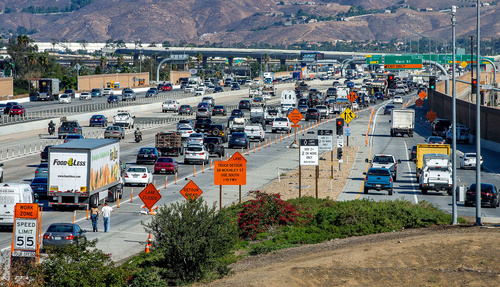
Q: Steve Ledder of Sun City, a community in Menifee, asked about drivers who exceed the speed limits in construction or work zones where posted signs say not to exceed the speed limit of 55 mph. “Many do, however. I take the signs to mean 55 mph 24/7. So, passing on that stretch at 11 p.m. on Christmas Eve, 55 mph still applies, right?”
A: Yep, it sure does. Reduced speed limits in construction zones must be followed at all times, 24/7, even on holidays or when workers aren’t present. This is not just for the safety of the workers, but also because construction zones could have other hazards that aren’t as apparent like trenches, uneven pavement, and narrowed lanes. Drivers should heed the lower speed limits and know that sometimes, highway patrol officers hang around construction zones for speed enforcement and will hand out what could be a very expensive citation. Remember, fines for speeding in California are doubled in construction zones.
Q: Dennis Bailey of Menifee asked why Caltrans workers don’t do freeway sweeping and clean-up work in the evenings, when traffic is lighter. Bailey referenced a recent sweeping operation when Caltrans had the emergency lanes blocked around 8:30 a.m. until at least 12:30 p.m. so workers could use a vacuum street sweeper on the northbound and southbound lanes of the 215 Freeway in Perris. Bailey said traffic was backed up for miles while the sweeping was underway. “Traffic is bad enough no matter what freeway we are on but why couldn’t Caltrans schedule this later in the evening when there is less traffic. Caltrans has the ability to work nights with safety lights and vehicles.”
A: Visibility and safety are the issues in this situation. Caltrans Spokesman Eric Dionne said crews perform sweeper operations during daytime hours for the safety of not only the employees but also the traveling public.
“It is also not only safer for all who travel on the state right-of-way, but it is also not efficient for the crews ahead of the sweeper to scan for larger items that may damage sweeper components at night,” Dionne said.
Q: Don Cayer of Ontario asked why tractor trailers are still allowed to drive on the 71 between the 60 and 10 freeways considering all the road construction and the poor condition of the road. “Lanes go from four to two northbound and if there are trucks in the lanes, there will be a bottleneck to the 60 because of poor driving choices,” he said.
A: The 71 is a state highway and commerce via big trucks is part of life. Road work itself isn’t a reason to ban large trucks from a state highway; big rigs already are banned or restricted from driving on many streets in various Inland cities.
“Unless there is an extreme hazard, preventing commerce from going through a highway isn’t something that typically happens,” said California Highway Patrol Officer Dan Olivas.
Do you commute to work in the Inland Empire? Spend a lot of time in your vehicle? Have questions about driving, freeways, toll roads or parking? If so, write or call On the Road and we’ll try to answer your questions. Please include your question or issue, name, city of residence, phone number and email address. Write ontheroad@scng.com or call 951-368-9670.
